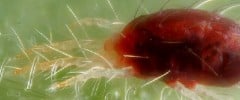How to Identify and Manage Spider Mites

Spider mites are tiny, but they pack a serious punch. These pests are among the most common in the interior landscape, with more than 1,200 known species that feed on hundreds of different plants. Because they are difficult to see with the naked eye, spider mite infestations often go unnoticed until significant damage has already occurred.
While spider mites can live in many environments, they thrive in hot, dry conditions. In interiorscapes, the most common species is the two-spotted spider mite (Tetranychus urticae), which commonly targets palms and other tropical foliage. Even a small population can spread quickly, making early detection essential.
Why Spider Mites Are Destructive To Plants
The feeding habits of spider mites make them especially harmful to foliage. By piercing plant cells and extracting chlorophyll, they rob plants of their vitality and reduce their ability to photosynthesize. As a result, foliage becomes dry, discolored, and stressed. Affected leaves often drop prematurely, further weakening the plant. If left untreated, a spider mite infestation will eventually kill the plant.
How to Identify Two-Spotted Spider Mites
To identify the two-spotted spider mite, use a magnifying glass with at least 10x magnification. These pests are typically found on the undersides of leaves, but when populations become high enough, they may spread to the tops as well. Adult mites vary in color, typically appearing creamy but can range anywhere from green to red or even purple. On larger adults, you can easily see the two distinct spots on their backs. Adult mites have eight legs, while immature mites have only six. Their eggs are usually translucent, turning cream-colored just before hatching. Two-spotted spider mites often live in colonies that produce webbing, which protects them and allows them to move easily between feeding sites.
Signs of a Spider Mite Infestation
Spider mites are difficult to see directly, but they leave behind clear warning signs on plants.
Indicators on foliage include:
- Chlorosis
- Fine webbing
- Brown or yellow speckling

Their damage is often easier to spot than the pests themselves. Look for dry patches, splotches, or leaves that appear scorched in severe infestations. You can also tap a branch or leaf over a sheet of white paper—the mites will fall onto the surface, making them easier to identify.
Spider Mite Life Cycle
Under the right conditions, two-spotted spider mite eggs hatch in as little as three days. After hatching, the mites move through a larval stage and then two nymph stages before reaching sexual maturity. The entire process takes between one and three weeks, and adults can live for two to four weeks. With such a rapid reproductive cycle, populations multiply quickly—one adult female can spawn massive numbers of mites in a short time. This speed also makes chemical control methods more difficult.
Spider Mite Control Methods for Interiorscapes
Once you’ve determined that two-spotted spider mites are the problem, it’s time to decide which control method to use. For small plants, removal may be the best option. Since spider mites can travel on air currents to find new hosts, removing infested plants helps keep them from spreading. If removal isn’t an option, predatory mites are commercially available and work well in interiorscapes. Two commonly used species are Phytoseiulus persimilis and Neoseiulus californicus.
When chemical treatments are needed, options such as insecticidal soaps and horticultural oils are available. Always read the label to make sure the product is safe for your plant variety, and take care not to overspray, as these compounds can make floors slippery or damage non-target surfaces. It’s essential to get complete coverage, especially on the undersides of leaves where most two-spotted spider mites live. For soaps and oils to work, they must come into direct contact with the mites.
There are also miticides that, when sprayed on the top of the leaf, move through to the underside. Avid (abamectin) is one such product registered for indoor use in most states. This product will not kill eggs, so a repeat application will be necessary.
Pest control labels vary by state, and it is the user’s responsibility to consult the pesticide label and adhere to the law. Always read carefully before applying a pesticide to ensure it is legal for use on your site, in your state, and on the specific plant material.
Preventing Spider Mite Infestations
Prevention is always easier than dealing with a full-blown spider mite infestation. Because these pests can hitch a ride on dusters, rags, or pruning tools, it’s important to keep equipment clean between plants and job sites. When new plants arrive—especially palms—inspect them closely for mites, and consider washing them down before installation.
Battling other common indoor plant pests? Check out my guide below for tips on managing whiteflies, thrips, fungus gnats, mealybugs, aphids, and scale insects.
You May Also Like
One response to “How to Identify and Manage Spider Mites”
Leave a Reply
You must be logged in to post a comment.



















There is another spider mite other than the one mentioned in this article that is even smaller and much harder to see even with a magnifier. They are darker that the 2 spotted mite. At our company the techs call them “ghost mites” and they often get on Sheff’s and Neanthebella palms. Very difficult to see and they don’t form webs.